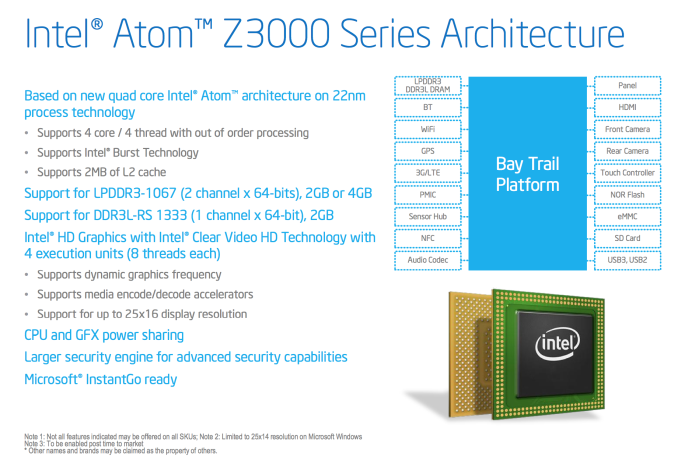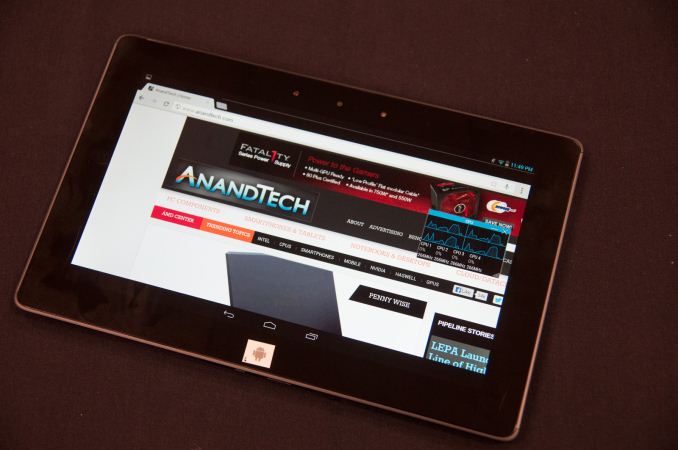The Bay Trail Preview: Intel Atom Z3770 Tested
by Anand Lal Shimpi & Brian Klug on September 11, 2013 12:00 PM ESTFinal Words
At its Silvermont disclosure, Intel promised performance better than any other ARM based core in the market today. Looking at our Android results, Intel appears to have delivered on that claim. Whether we’re talking about Cortex A15 in NVIDIA’s Shield or Qualcomm’s Krait 400, Silvermont is quicker. It seems safe to say that Intel will have the fastest CPU performance out of any Android tablet platform once Bay Trail ships later this year.
The power consumption, at least on the CPU side, also looks very good. From our SoC measurements it looks like Bay Trail’s power consumption under heavy CPU load ranges from 1W - 2.5W, putting it on par with other mobile SoCs that we’ve done power measurements on.
On the GPU side, Intel’s HD Graphics does reasonably well in its first showing in an ultra mobile SoC. Bay Trail appears to live in a weird world between the old Intel that didn’t care about graphics and the new Intel that has effectively become a GPU company. Intel’s HD graphics in Bay Trail appear to be similar in performance to the PowerVR SGX 554MP4 in the iPad 4. It’s a huge step forward compared to Clover Trail, but clearly not a leadership play, which is disappointing.
The big unknowns are things like video decode power efficiency, perf and quality of their ISP and idle power efficiency vs. Qualcomm.
Bay Trail looks like a good starting point for Intel in mobile, and the performance of Silvermont makes me excited for Merrifield in phones next year. What Intel needs to do going forward is simply continue to iterate and execute for the next few generations after Bay Trail and it will have a real chance at success in mobile.
My biggest concern is about the design wins we see based around Bay Trail. Although Intel is finally in a spot where it can be in devices on the market, none of those devices thus far have been any good. Bay Trail is attractive enough to garner more design wins for certain, the question is whether or not the quality of those wins will improve as well. In the tablet market there’s the iPad and the Nexus lines that are really the most interesting, and I don’t expect Bay Trail to be in either. Whether or not the quality of the rest goes up this generation and we find a Bay Trail in one of those devices remains to be seen.












190 Comments
View All Comments
Nagorak - Wednesday, September 11, 2013 - link
Samsung already used the old Atom in their Galaxy Tab 3 10.1, and they make their own ARM licensed cores in-house. It's not going to take much to get these venders to switch. If the performance is there, and the price is competitive, plenty will make the switch. These OEMs design electronics as their business, it's not going to be a huge difficulty for them to make designs with Atom cores instead of ARM cores. And considering X86 works with both Windows and Android, I don't see why having a higher compatibility base is somehow a negative.Dentons - Wednesday, September 11, 2013 - link
Keep in mind that ARM allows mobile device manufacturers a large, competitive marketplace from which to purchase CPU's.Were tablet manufacturers to spurn ARM, they'd drop themselves right back into Intel's high-margin, nearly monopolistic arms.
So why have Samsung and Asus released Android devices featuring Intel CPUs? Both Samsung and Asus purchase a lot of expensive Intel chips for their laptops. It would be less than surprising were they to have been compensated with discounts for having released Intel powered Android devices.
Another huge problem for X86 Android is software support. Nearly all Android applications are compiled for the ARM instruction set. The hundreds of thousands of existing Android apps *WILL NOT RUN* on an Intel powered Android devices. At best, they need recompilation, at worst, rewriting. Moving hundreds of thousands of ARM compiled software to X86 is a heavy lift. Intel has a recompilation service, but it's only able to do so much.
The bottom line is that Intel is just now, finally releasing a CPU competitive with ARM. ARM has a massive lead. A larger lead than Intel has ever had in the PC market. To convince manufacturers to relinquish ARM for X86, Intel doesn't just need minimally better technology, they need far better technology and equal or better pricing.
Right now, Intel's technology is not that much better than ARM, and their pricing? Unless they decide to sell below cost, they'll likely never beat ARM pricing.
jwcalla - Wednesday, September 11, 2013 - link
I agree with much of this but I think you're a bit off on the Android applications aspect. A vast vast majority of the Android apps are written in Java so there's not incompatibility with x86 there. For the native apps, recompiling to x86 is somewhat trivial since Android is a Linux OS. Third, it seems that Intel's ARM-to-x86 ISA translation program works pretty well.h-jumbo - Thursday, September 12, 2013 - link
Yes - and to further correct Dentons comment on Android compatibility, Intel has a binary translator for Android that will convert ARM ISA to x86 on the fly. It works amazingly well. If x86 gets more traction in Android devices, it will be used less and less as app developers compile for x86 in addition to ARM (which is trivial).JPForums - Thursday, September 12, 2013 - link
Wow, you just talked about Intel killing off WinRT and then moved on to talking about a lack of applications for Windows. You can't have it both ways. Either legitimize WinRT as a competitor and bash it for a lack of applications or (more realistically) dismiss WinRT and accept that Windows has more applications, higher quality, and fully featured than any app store. Since when did a fully featured application become inferior to an app. How many (software) things can you do on a tablet that you can't do with a Windows PC or even OSX. Let's even throw Linux in their for kicks and grins.
Also consider that the biggest advantage of maintaining a process lead is cost. Yes a new process cost more than an old process, especially when applying new techniques like double masking and tri-gates, but the bulk of the cost is still in the silicon. The exact same chip fabricated on a smaller process generically means lower cost due to the ability to fit more chips per wafer. Intel maintains the highest margins in the industry because they also maintain the lowest cost per comparable chip. I'd imagine that Intel will give these chips a price tag to match (or slightly exceed) their level of performance compared to their ARM competition. Unfortunately, as you said, simply being competitive isn't enough to justify a rapid switch over of an ARM dominated market. They are going to need to offer something the their competitors don't have or eat significantly into their margins. That said, they will get some design wins simply by being competitive and being Intel. Pickup into the Windows market will help as manufacturers could conceivably use the exact same or very similar hardware to power both a Windows and an Android tablet, saving cost. This could fuel a slow long term takeover, but like you, I don't see a sudden switch.
lmcd - Wednesday, September 11, 2013 - link
So in that whole power comparison versus Jaguar where was the graphics disclaimer? I think the pounding seen here easily warrants the TDP difference.eanazag - Wednesday, September 11, 2013 - link
The 3DMark extreme bench scores look suspect. I think the graphs are swapped.Clearly AMD's graphics in Kabini smoke Intel's products and many other non-IvyBridge GPUs. I wonder how much of a power hit did Kabini take to produce that. Meaning, would a comparable performing GPU to Intel's make the power to performance ratio be more favorable at maybe 3.5W max under load? I am not thinking if Kabini was cut down on the GPU to even Bay Trail that it would beat Intel's power consumption. I suspect it would be closer.
I am irritated they don't just call it Atom on desktop and laptop. Clearly trying to get out of the netbook Atom stigma. Whatever. Ultimately, I am still disappointed that Atom doesn't do enough on the GPU side. It still leaves me as a consumer having to make a choice between graphics intensive and CPU intensive workloads. And the fact AMD's Kabini is even close on CPU performance is a weak showing because Intel has a mature process node advantage on virtually everyone now.
PEJUman - Wednesday, September 11, 2013 - link
more improtantly, can someone explain how Anand was able to run android with x86 kabini and x86 ivy bridge on the android GPU bench? since when can x86 processors run ARM natively? if not, did Intel actually let Anand use their android pre-beta port at the other 2 platforms?Jaybus - Wednesday, September 11, 2013 - link
Android has run on x86 for a long time. Android is Linux-based.PEJUman - Wednesday, September 11, 2013 - link
yeah but I was under the impression it uses VM and an custom build on that. Anand was able to run GPU bench (I assumed this meant native x86 build), with 4.2.2 build at that. Isn't android is built for ARM only?